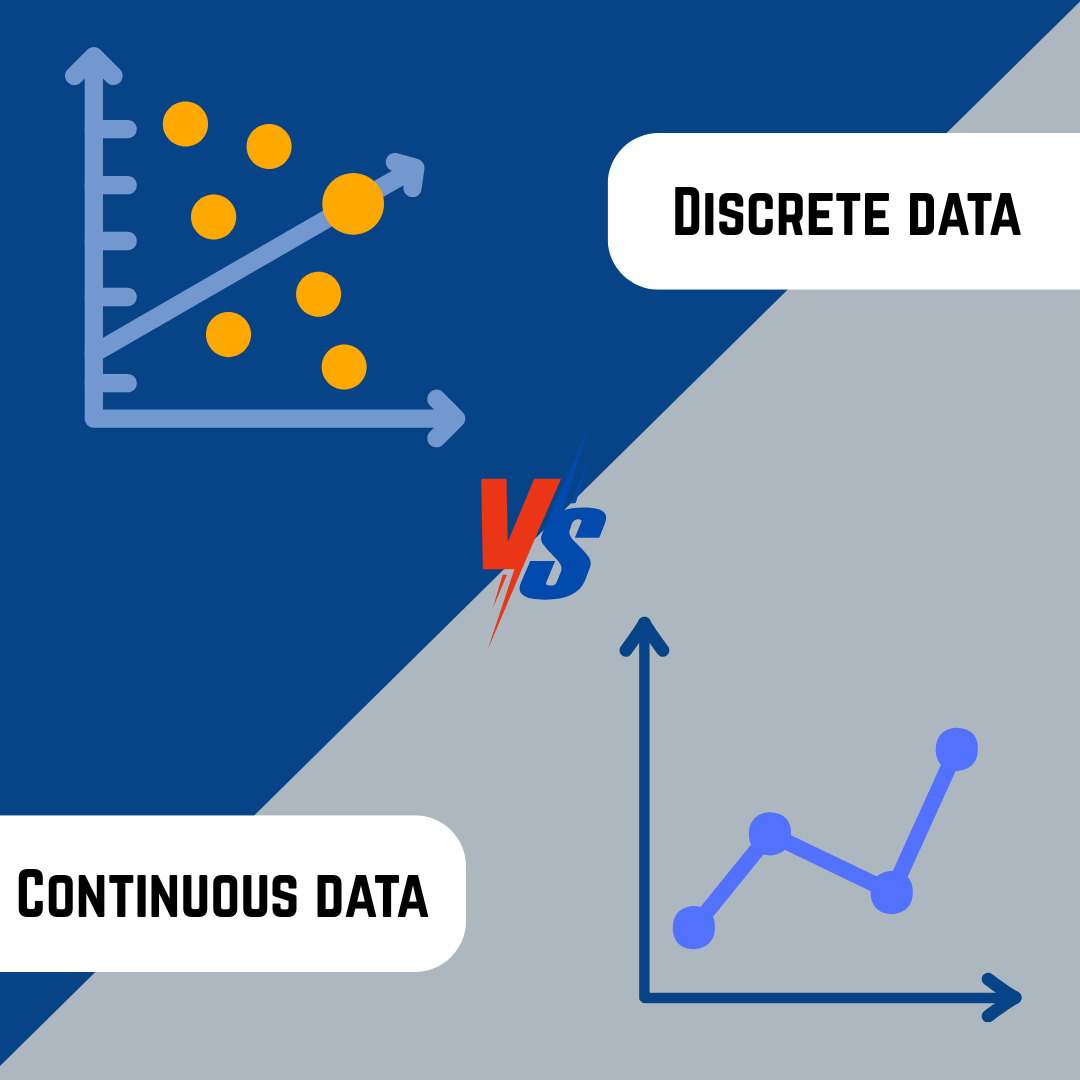
Understanding data types is crucial for accurate data analysis, statistical studies, and even making day-to-day decisions. Among the core types of quantitative data are discrete and continuous data, each serving unique purposes and applications in statistical analysis, science, and business. In this article, we’ll dive into the differences between discrete and continuous data, along with clear examples to help illustrate their applications.
What is Discrete Data?
Discrete data refers to countable quantities, where values are distinct, separate, and finite. Discrete data often represent whole numbers and cannot be subdivided. Typically, it involves items or entities that can be counted individually, like the number of people in a room, the score on a test, or the number of cars in a parking lot. Discrete data values have fixed gaps between them, meaning you can’t have a fraction or decimal between two discrete numbers.
Characteristics of Discrete Data
- Countable: Discrete data are always countable quantities.
- Non-divisible: Values can’t be subdivided or fractioned.
- Specific values only: Discrete data takes specific values without intervals, such as integers.
- Finite or Infinite Sets: Discrete data can belong to a finite set (like days of the week) or an infinite set (like counting numbers).
Examples of Discrete Data
- Number of Books on a Shelf: You can have 15, 20, or 25 books, but not 15.5 books.
- Exam Scores: Scores are usually whole numbers, like 75 or 80, without subdivisions.
- People Count: In a group, there could be 12, 15, or 20 people but not 12.8 people.
- Pets Owned per Family: Families may own 1, 2, or 3 pets, and the numbers remain whole and countable.
What is Continuous Data?
Continuous data represents measurable quantities that can take on an infinite range of values within a given interval. Unlike discrete data, continuous data can include fractions, decimals, and more precise values between whole numbers. Continuous data applies to measurements, such as weight, time, and temperature, where there’s theoretically no limit to the granularity of measurement.
Characteristics of Continuous Data
- Measurable, not countable: Continuous data is often collected by measurement.
- Divisible into finer parts: Values can be subdivided infinitely, offering finer precision.
- Range of Values: Continuous data takes any value within a range, including decimals.
- Dependence on Measurement Tools: Precision often depends on the instrument used.
Examples of Continuous Data
- Height of a Person: Heights can be measured to various levels of precision, such as 5 feet, 5.5 feet, or even 5.55 feet.
- Temperature Readings: Temperature can take a wide range of values, such as 20.5°C, 20.55°C, etc.
- Time Duration: Time can be measured to milliseconds, seconds, minutes, and beyond.
- Weight of Objects: Weights can have precise measurements like 70 kg, 70.5 kg, or 70.55 kg.
Key Differences Between Discrete and Continuous Data
| Aspect | Discrete Data | Continuous Data |
| Definition | Countable and finite values | Measurable values within an infinite range |
| Precision | Fixed values, typically whole numbers | Infinite precision, including decimals |
| Measurement Type | Counting | Measuring |
| Examples | Number of students, books, cars | Temperature, time, height |
| Sub-divisibility | Cannot be subdivided into smaller units | Can be subdivided infinitely |
Why Knowing the Difference Matters
1. Statistical Analysis
Discrete and continuous data have distinct statistical approaches. Discrete data often involve counting methods or frequency distributions, whereas continuous data analysis involves histograms, normal distributions, and measures like standard deviation. Understanding these differences is crucial when choosing appropriate statistical tools and methods.
2. Data Collection and Measurement
Continuous data generally require precise instruments for measurement, such as thermometers for temperature or scales for weight. On the other hand, discrete data relies on simpler, count-based collection methods, which can be easier and less costly to obtain.
3. Accuracy in Business Decisions
In business, using the right data type ensures more accurate insights. For example, when analyzing inventory (discrete data), knowing exact counts is essential for stock management. In contrast, if you’re evaluating product weight (continuous data), precision is critical for packaging and shipping logistics.
Applications of Discrete Data
Discrete data finds applications across various fields:
- Inventory Management: Counting stock items or products in supply chains.
- Healthcare: Counting the number of patients or visits within a time frame.
- Education: Grading and scoring systems that use whole numbers.
- Financial Services: Counting transactions or frequency of purchases.
Applications of Continuous Data
Continuous data plays an integral role in:
- Scientific Research: Experiments often involve measuring time, weight, or temperature.
- Economics: Continuous metrics like income levels, inflation rates, and interest rates.
- Engineering: Precision measurements for designing and manufacturing.
- Weather Forecasting: Tracking continuous data on temperature, humidity, and atmospheric pressure.
Visualizing Discrete vs. Continuous Data
The choice of graphs or charts varies depending on data type:
- Discrete Data: Bar charts, pie charts, and dot plots work well, as they display counts or frequencies clearly.
- Continuous Data: Histograms, line charts, and scatter plots are ideal, allowing visualization of trends, ranges, and continuous variations.
How to Determine if Data is Discrete or Continuous
Determining whether data is discrete or continuous often depends on the nature of the question and the method of data collection. Ask the following questions to decide:
- Can I count it in whole numbers only?
If yes, it’s likely discrete data. - Is it possible to measure and get precise, fractional values?
If yes, it’s continuous data. - Is the data a part of a countable set or an infinite range?
Countable sets are typically discrete, while infinite ranges indicate continuous data. - Does the data represent a specific category?
If data points fall into specific, countable categories, they’re generally discrete.
Conclusion
Understanding the fundamental differences between discrete and continuous data provides essential clarity for accurate data analysis. Discrete data involves countable, finite values, while continuous data covers a measurable range with the potential for infinite precision. Knowing when to use each data type is essential for making precise measurements, applying accurate statistical methods, and obtaining meaningful insights from any data set.
1: Can discrete data be negative?
Yes, discrete data can be negative if it involves values like net profit or loss, which can go below zero.
2: Is time discrete or continuous data?
Time is considered continuous data since it can be divided infinitely, with values such as seconds, milliseconds, and microseconds.
3: How does continuous data affect precision?
Continuous data allows for more precise measurements since it can include fractional or decimal values, improving accuracy in scientific and technical fields.
4: Is age considered discrete or continuous data?
Age can be considered both. For simplicity, it’s often treated as discrete (e.g., 25 years), but it can be continuous if measured precisely (e.g., 25.6 years).
5: How are discrete and continuous data used in machine learning?
In machine learning, discrete data is typically used in classification models, while continuous data is useful for regression models.


